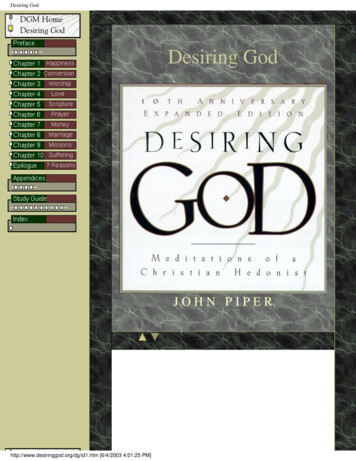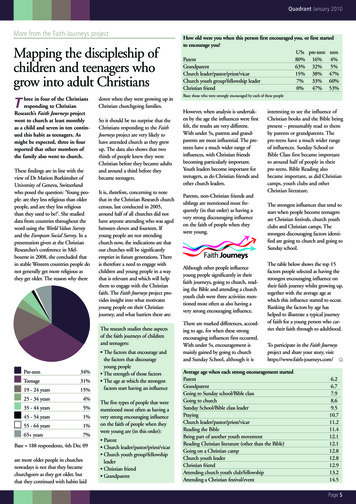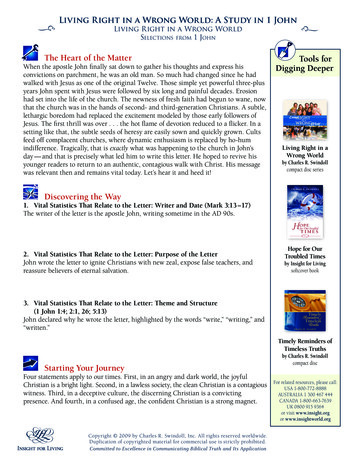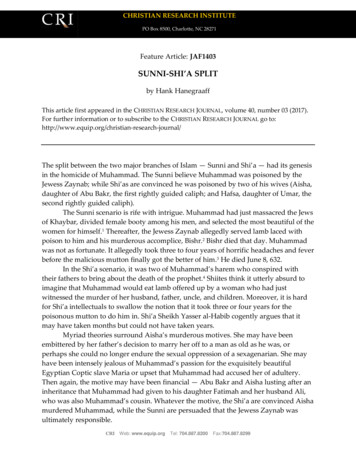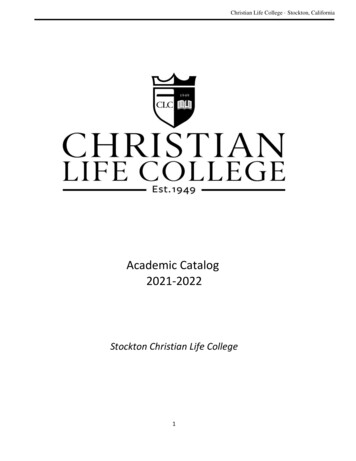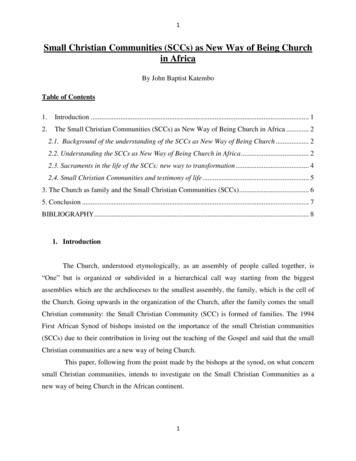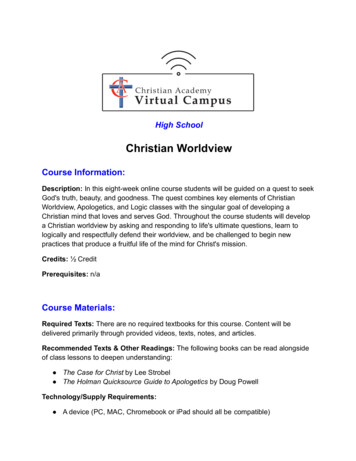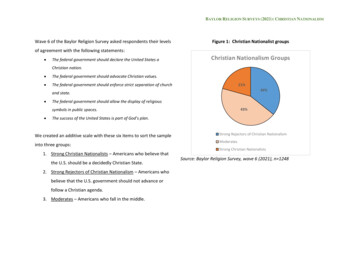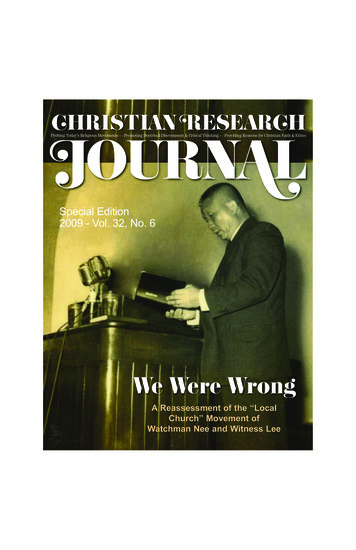
Transcription
CRJ Magazine 32-06 Special Edition Layout 1 2/22/2010 2:35 PM Page 1Probing Today’s Religious Movements — Promoting Doctrinal Discernment & Critical Thinking — Providing Reasons for Christian Faith & EthicsSpecial Edition2009 - Vol. 32, No. 6We Were WrongA Reassessment of the “LocalChurch” Movement ofWatchman Nee and Witness Lee
CRJ Magazine 32-06 Special Edition Layout 1 2/22/2010 2:35 PM Page 2CRI 2.0Christian Research Instituteand the Bible Answer Man broadcast invite you tojoin us in community and dialog on the internet.FIND US ATYouTube http://www.youtube.com/CRInstituteVimeo at http://vimeo.com/channels/51527FOLLOW US ON /cribamhttp://www.twitter.com/crjournalCHECK US OUT ON READ HANK’S LATEST THOUGHTS ON HIS BLOGhttp://hankhanegraaff.blogspot.comBECOME A CRI FAN ON ges/Bible-Answer-Man/55979377851On the Internet (including 24-Hour Credit Card Ordering): www.equip.orgBy Mail:CRI United StatesP.O. Box 8500Charlotte, NC 28271-8500In Canada:CRI Canada56051 Airways P.O.Calgary, Alberta T2E 8K5By Phone:U.S. Toll-Free Customer Service Line(888) 7000-CRIFax (704) 887-8299Canada Toll-Free Credit Card Line(800) 665-5851Canada Customer Service(403) 571-6363On the Broadcast:To contact the Bible Answer Manbroadcast with your questions, call tollfree in the U.S. and Canada, (888)ASK HANK (275-4265), Monday–Friday, 5:50 p.m. to 7:00 p.m. EasternTime. For a list of stations airing theBible Answer Man broadcast, or tolisten online, log on to www.equip.org.
eou tonet.1gCRJ Magazine 32-06 Special Edition Layout 1 2/22/2010 2:35 PM Page 3The “Local Church”32/0607 Cultic, Aberrant, or (Unconventionally) Orthodox?A Reassessment of the “Local Church” MovementCONTENTSby Elliot MillerNew Religious Movements/Doctrinal Discernment: One of the largest and most dynamicChristian movements in China, the “local churches” (LC) of Watchman Nee and WitnessLee, planted churches in the United States beginning in the 1960s. It was greeted withsuspicion by the evangelical community, and it was not long before CRI and otherdiscernment ministries began labeling it heretical. But, after a six-year reevaluation, CRIhas concluded that the LC has been misunderstood and is neither cultic nor aberrant, butmerely different. Learn the reasons why in this special five-part article, along with somevaluable lessons on how to do—and not to do—discernment ministry08 Part 1: The “Local Church” asMovement and Source of ControversyThe LC have persevered through persecution in China and charges of cultism in theWest. Here is an overview of their history, from the conversion of Watchman Nee in1920 to the release in 2007 of an “open letter” calling on them to withdraw three of theteachings of Witness Lee and to renounce their use of litigation against Christians14 Part 2: Addressing the Open Letter’sConcerns: On the Nature of GodWitness Lee said that Jesus is both the Father and the Holy Spirit. He also deniedthat he was teaching the ancient heresy of modalism. Lee’s critics insist that thesetwo statements are contradictory, but have they missed something in Lee’s writingsthat would reconcile them?24 Part 3: Addressing the Open Letter’sConcerns: On the Nature of HumanityWitness Lee taught that the culmination of God’s salvation plan is for believers tobecome God. This sounds heretical, but before setting Lee’s books on fire (or addingour names to an open letter), shouldn’t we first find out what he meant by that?04 From the President32 Part 4: Addressing the Open Letter’s Concerns:On the Legitimacy of Evangelical Churches and DenominationsWitness Lee wrote that “the denominational organizations have been utilized bySatan to set up his satanic system to destroy God’s economy of the proper churchlife.” By this many Christians assume Lee is claiming that only his movement hastrue churches and that denominational Christians are lost and outside the universalchurch; but these have never been Lee’s claims06 Effective EvangelismSpiritual Boot Camp51 Ask Hank38 Part 5: Addressing the Open Letter’sConcerns: On Lawsuits with Evangelical ChristiansThe “local church” movement has sued evangelical publishers and authors three timesin the past three decades. To many evangelicals this makes the LC aggressors and theauthors and publishers victims. Again, however, things are not as simple as they seemAre the Local Churches,Founded by Watchman Neeand His Protégé Witness Lee,a Pseudo-Christian Cult?47 The Conclusion of the Matter: We Were Wrong48 No Longer a Heretical Threat; Now Dear Brothers andSisters in Christ: Why, concerning the Local Churches,I No Longer Criticize, but Instead Commendby Gretchen PassantinoNew Religious Movements/Doctrinal Discernment: The coauthor of the first publishedcritique of the LC in America explains how it was possible for researchers andministries with well-earned reputations for accuracy to get it so wrong when it cameto the LCCHRISTIAN RESEARCH JOURNAL03equip.org
CRJ Magazine 32-06 Special Edition Layout 1 2/22/2010 2:35 PM Page 4FROM THE PRESIDENTWe Were Wrong!he JOURNAL you hold in your hand features theculmination of a six-year research project respecting amovement originally founded by a Chinese Christiannamed Watchman Nee. While Nee died for his Messiah in aCommunist prison camp, his ministry did not die with him.Under the leadership of protégé Witness Lee, Nee’s ministry andmessage spread from China throughout the Pacific Rim nationsranging from Singapore to Taiwan and eventually to the West. In1962 Lee moved to Southern California and established the localchurches and their publishing arm Living Stream Ministry.1As President of the Christian Research Institute (CRI), Iinherited a wealth of information on cults, the occult, andaberrant Christian theologies. My assumption was that as anorganization committed to first-rate primary research theinformation in our files was substantially correct. Over the pasttwenty plus years this assumption has been validated time andtime again. But not always. In the mid ‘70s the ChristianResearch Institute in collaboration with researchers Bob andGretchen Passantino initiated an evaluation of the local churchesthat would become a fountainhead of misinformation.This reality began to surface in 2003 when I askedGretchen Passantino and Elliot Miller, editor-in-chief of theCHRISTIAN RESEARCH JOURNAL, to join me for a meeting withrepresentatives of Living Stream Ministry. During the meeting Iheard stirring affirmations of the very doctrines the localchurches allegedly denied. One by one, and in their own words,representatives of the local churches testified to their belief inone God, revealed in three persons who are eternally distinct; tothe reality that human beings can never ontologically attainGodhood; and to the fact that they were “only the church” asopposed to being “the only church.”As a result, I initiated a research project culminating in theexpanded cover story of this Special Edition of the CHRISTIANRESEARCH JOURNAL. Primary research was conducted not only inthe U.S. but in such faraway places as China, Taiwan, South Korea,and England. It involved careful evaluation of literally hundreds ofbooks, papers, church documents, and audio and video recordings.Even court documents.2 The result of our primary research isencapsulated in the following three words: “We were wrong!”Gretchen Passantino uttered the words, “I was wrong,” to abeliever in Shanghai who had been in prison from the time hisdaughter was born to the time she turned seventeen. Elliot Millersaid, “I was wrong,” to a man in Fuqing who had sufferedimprisonment for a total of twenty-four years. Their words werenot merely uttered in the moment of emotion. No! They wereuttered after years of painstaking primary research.While we have significant doctrinal differences with thelocal churches on nonessentials such as aspects of eschatology(my book, The Apocalypse Code, testifies to that reality), whenit comes to essential Christian doctrine—the very doctrines forTequip.org04CHRISTIAN RESEARCH JOURNALwhich the martyrs spilled their blood—we stand shoulder-toshoulder.The Christian Research Institute is no stranger tocontroversy. Y2K is a classic case in point. The cover story of a1999 edition of the CHRISTIAN RESEARCH JOURNAL was titled“The Millennium Bug Debugged.” As a result, we werecharacterized as “blind to truth” or “downright uninformed,” likean ostrich with our head in the sand. When I suggested on theBible Answer Man broadcast that Y2K would not even be a topten news story in the year 2000, I was accused of causingcomplacency in the body of Christ. One broadcaster went so faras to say that I would have the blood of millions of Christians onmy hands because I was causing complacency in the body ofChrist. I experienced the wrath of Christian gate-keepers, whowere selling freeze-dried food and survival kits, and of people inthe pews, who were absolutely certain that their leaders—particularly those politically connected—could not possibly bewrong on such a crucial matter.Another significant controversy involved HerbertW. Armstrong’s Worldwide Church of God. I still vividly recallthe controversy that erupted in the ‘90s when I began meetingwith church leaders. Yet, in 1994 the CHRISTIAN RESEARCHJOURNAL and the Bible Answer Man broadcast were privilegedto be first to announce publicly that the Worldwide Church ofGod had embarked upon a course virtually uncharted inchurch history—a course that took them from the kingdom ofthe cults to the kingdom of Christ.3 Moreover, I was blessed tobe able to write the foreword to a book by Joseph Tkach,President of the Worldwide Church of God, titled Transformedby Truth. Today he is not only my dear friend, but my brotherin Christ—one who has made the pilgrimage from cultism toChrist.In those days our ministry was deeply grateful for thefriendship and support extended to “The Church Reborn” bycult expert Dr. Ruth Tucker, Christianity Today’s David Neff,Azusa Pacific University, Fuller Seminary, and Regent College.Together we believed that if God could redirect entire movementsby changing the hearts of leaders, there was no telling what Hemight yet do through our continued faithfulness.Joseph Tkach, by God’s grace was able to utter the words,“We were wrong.” We now express those same wordsregarding our stance on Watchman Nee, Witness Lee, and thelocal churches.The cost has been significant. Integrity has beenquestioned, motives challenged, and slander has ensued. As aresult, support has been compromised. If I heard it once Iheard it a thousand times. How can seventy Christian leaderswho signed an open letter (see the cover story) calling thelocal churches to confess their false doctrines and practices bewrong? Surely, the integrity of CRI has been compromised.
CRJ Magazine 32-06 Special Edition Layout 1 2/22/2010 2:35 PM Page 5CHRISTIAN RESEARCH32 / 06JOURNALPublisher Christian Research InstitutePresident Hank HanegraaffExecutive Vice President Paul YoungChief Operating Officer Robert EatonVice President of Media Sam Wall Editor-in-Chief Elliot MillerManaging Editor Melanie M. CogdillArt Director Dwayne Cogdill / St. Dwayne Designwww.saintdwayne.comIn the midst of the turmoil I havereminded staff that ministry is no place for apopularity contest. That it is not about thesize of the platform. Or about politicalcorrectness. At the end of the day, we dowhat we do, because Truth matters!Whatever the cost it pales bycomparison to that borne by the persecutedchurch in China and around the world. Thatreality was memorialized in a momentforever emblazoned upon my mind. AChinese woman with brilliant smile had justfinished communicating the experience ofincarceration due to reading unauthorizedmaterial in an unauthorized meeting. Not ahint of self-pity. Only the radiance of afollower of Christ who had experienced thereality of authentic New TestamentChristianity. When she finished, she thankedme for standing for truth no matter the cost.Never have I felt more unworthy. WhateverI face pales by comparison to what she andmultitudes like her have suffered.Perhaps no three words are more likelyto stick in our throats than the words, “I waswrong.” Yet for a ministry committed to themaxim, “because Truth matters,” thewillingness to utter these words is not anoption, it’s an essential.—Hank Hanegraaff1 Because Nee had no intention of starting a new churchmovement or denomination, and because he considered himself“just a brother” and not a pastor or leader, there was no formaltransfer of “authority” from Nee to anyone else. Therefore, therehave always been some who have denied legitimacy to Lee’sleadership and who have, in fact, disagreed strongly with Lee’sunderstanding of Nee’s teachings. We have examined thesealternative interpretations and developments of Nee’s teachingsand do not believe that there is significant difference betweenNee and Lee, nor any compelling evidence that Nee and Leerepresent different teachings or different expressions of thechurch.2 Elliot Miller and Gretchen Passantino, who had participated inthe original research in the 1970s, were in a unique position toevaluate deficiencies. Bob Passantino died in November 2003and was therefore not able to contribute to the recent research.Before his death, however, he agreed with his wife and ministrypartner, Gretchen, that a reevaluation was necessary and waslikely to determine that the original research was at bestincomplete and at worst grossly inaccurate.3 Joseph Tkach, Transformed by Truth (Sisters, OR: MultnomahBooks, 1997), 54.Consulting Editor Stephen RossCopy Editors Lee A. Dean, Amy LeonhardtContributing WritersPaul Copan, Joe Dallas, R. Douglas Geivett,Douglas Groothuis, Edmond C. Gruss,Joseph P. Gudel, Gary Habermas, Daniel Hoffman,James Patrick Holding, H. Wayne House,Richard Howe, Thomas Howe, Eric Johnson,Scott Klusendorf, Doug LeBlanc, Gordon R. Lewis,Ralph E. MacKenzie, Daniel Mann,C. Wayne Mayhall, Bill McKeever,Marcia Montenegro, Sharon Fish Mooney,Paul A. Nelson, Warren Nozaki, Rachel Ramer,Mark Ryan, Carole Ryan, Charles Strohmer,Gene Edward Veith, Robert Velarde,James R. WhiteCustomer Service Desiree MillerHank HanegraaffAs an organ of the Christian Research Institute (CRI), theCHRISTIAN RESEARCH JOURNAL’s primary commitment is to “contendearnestly for the faith which was once for all delivered to thesaints” (Jude 3). In keeping with this commitment, theJOURNAL’s mission is both evangelistic and pastoral: evangelistic in that it is dedicated to furthering the proclamation anddefense of the historic gospel of Jesus Christ; pastoral in that itis dedicated to helping His followers identify and distinguishbetween essential Christian doctrine and doctrine that isperipheral, aberrant, or heretical.CRI’s areas of research specialization include (1) nonChristian religions, sects, and cults; (2) the world of the occult(including practices, phenomena, and movements); and(3) issues of contemporary theological and apologetic concern(e.g., aberrant Christian teachings and practices; philosophicaland historical speculations that challenge biblical reliability;relativistic ethics that compete with biblical ethics forinfluence on culture and public policy; and sensationalconspiracy theories). In its approach to all of these themes, theJOURNAL strives to be at once scholarly and readable, uncompromising and charitable; offering analyses and critiques thatare biblically, rationally, and factually sound.Western culture is deeply embroiled in a spiritual crisis.In the face of many conflicting and confusing claims to humanallegiance, may believers be prepared to give logically andhistorically sound reasons for faith in Jesus Christ. In an ageof subjectivism and moral relativism, may Christians groundtheir faith and values in the objective, reliable testimony ofHoly Scripture.News clippings about cultic or occult activity aroundthe world are welcome. Freelance writers: Please e-mailqueries or manuscripts to submissions@equip.org. CHRISTIANRESEARCH JOURNAL does not take responsibility for return orpublication of unsolicited manuscripts. Manuscripts areevaluated on a quarterly basis. Please allow at least fourmonths for a reply. Postmaster: Send changes of address toChristian Research Institute, P.O. Box 8500, Charlotte, NC28271-8500 USA.MemberEvangelical Press Association
CRJ Magazine 32-06 Special Edition Layout 1 2/22/2010 2:35 PM Page 6EFFECTIVE EVANGELISMSpiritual Boot Camphe gospel is at the heart of the Christian faith. IfChristians do not know how to share their faith, theyhave probably never been to “boot camp.” The gospelshould be so much a part of you that presenting it becomessecond nature. Here’s an easy way to do just that.The first step involves developing a relationship with anunbeliever. This includes using your personal testimony as abridge into sharing the good news of the gospel. This is theinverse of grabbing somebody by the lapels and shouting,“Brother, are you saved?”After a relationship is established, you can movenaturally into a presentation of the gospel using the alliteratedwords realize, repent, and receive.First, according to Scripture, people need to realizethat they are sinners. If we do not realize that we aresinners, we will not recognize our need for a savior. TheBible says we “all have sinned and fall short of the gloryof God” (Rom. 3:23).Furthermore, one must repent of their sins. Repentance isan old English word that describes a willingness to turn fromsin toward Jesus Christ. It literally means a complete U-turnon the road of life—a change of heart and a change of mind.It means having a willingness to follow Jesus and receive Himas Savior and Lord. Jesus said, “Repent and believe the goodnews!” (Mark 1:15).Finally, true belief means a willingness to receive. To trulyreceive is to trust in and depend on Jesus Christ alone to bethe Lord of our lives here and now and our Savior for alleternity. It takes more than knowledge (the Devil knowsabout Jesus). It takes more than agreement that theknowledge we have is accurate (the Devil agrees that Jesus isLord). What it takes is trust in Jesus Christ alone for eternallife. The requirements for eternal life are based not on whatwe can do but on what Jesus Christ has done. He standsready to exchange His perfection for our imperfection.According to Jesus Christ, those who realize they aresinners, repent of their sins, and receive Him as Savior andLord are “born again” (John 3:3)—not physically, butspiritually. And with this spiritual birth must come growth.Because we are called to make disciples, not converts, wealso need to be equipped to lead those who receive Christ asSavior and Lord through the basic steps of discipleship andgrowth as new believers.Consider what would happen if every evangelicalChristian led just one person to faith in Christ each year. If webegan with only twelve committed Christians and each ofTequip.org06CHRISTIAN RESEARCH JOURNALthem led one person to Christ and discipled that person, nextyear there would be twenty-four believers. If each of them inturn led one person to Christ and discipled that person, thethird year there would be forty-eight believers. If this processcontinued, it would take less than thirty years to evangelizethe six billion or more people alive today on planet Earth! Ifin the same time frame the population doubled, it would takeonly one additional year.1Many people today run from church to church in searchof the ultimate experience. No experience, however, cancompare with that of the Holy Spirit working through you inthe process of bringing someone to a saving knowledge of theLord Jesus Christ.—Hank HanegraaffHank Hanegraaff is president of the Christian ResearchInstitute and host of the Bible Answer Man broadcast hearddaily throughout the United States and Canada. For a list ofstations airing the Bible Answer Man, or to listen online, logon to www.equip.org.1 I first heard a version of this illustration in 1980 while going through the EvangelismExplosion training process. The statistical illustration is pertinent even though it is not meantto convey that everyone who is evangelized will become a believer.
CRJ Magazine 32-06 Special Edition Layout 1 2/22/2010 2:36 PM Page 7Cultic, Aberrant, or(Unconventionally) Orthodox?A Reassessment of the“Local Church” MovementDby Elliot Milleruring the height of the Jesus movement in theearly 1970s, a young Northern Californiawoman who had recently converted to Christ accepted aninvitation to a meeting of Christians who identified themselves as “the church” in her city. When the members began toworship, this new Christian was unnerved by the group’spractice of “pray reading” Scripture and “calling on the nameof the Lord,” in which worshipers were loudly reading andrepeating Scripture verses and punctuating them with shoutssuch as “Amen!” “Hallelujah!” and “O Lord! Amen! Hallelujah!” After someone in the assembly proclaimed, “I cansense the human spirits mingling!” the young woman boltedfor the door, fearful she had stumbled into a cult meeting, orperhaps even a spiritualist séance.This anecdote from an old friend of mine captures theawkward tension that has existed between Westernevangelicals and the “local church” (LC)1 movement foundedin China by Watchman Nee and brought to America in 1962by Nee’s coworker Witness Lee. Their unconventional form ofworship, unfamiliar doctrines and terminology (e.g.,“mingling”), intense devotion to the ministries of Nee andLee, and the strong Chinese influence that is evident even inthe Western outposts of the movement, all have contributedto the perception that this group is strange at best and culticor heretical at worst. For many evangelicals these initialsuspicions only seemed confirmed when they studied LCliterature or dialogued with their members, since theyseemingly embrace unorthodox doctrines such as modalism(God is one person in three modes rather than three personsin one being) even while denying that they hold them.The Christian Research Institute (CRI), which publishesthis magazine, is no stranger to this controversy. Along withthe Spiritual Counterfeits Project (SCP) in Berkeley,California, in the mid to late 1970s we were among the firstto research and publish on the LC. Although we refused tocall them a cult,2 our highly critical evaluation was consultedand cited by numerous later critics, many of whom did nothave the same scruples about using the “c word.”3In 2003, however, we accepted an invitation by LCleaders to engage in dialogue with them about their beliefs.Over the following few years we discovered that we had beenprofoundly mistaken about some of their teachings. Furthermore, after several visits to the Far East we have come tobelieve that this movement represents a crucial work of Godin that region that our literature, and that of other Westerncountercult ministries, has greatly hindered.The purpose of this five-part article, then, is to offer afresh critique of the LC movement. After briefly looking attheir background as a movement and as a source ofcontroversy, we will take a long, hard look at what can fairlybe called the four major concerns evangelicals have expressedabout the LC. These were all succinctly presented in a 2007“open letter” to the LC signed by a long list of evangelicaltheologians, apologists, and leaders. We will then draw ourconclusions together and reassess where the LC stands inrelation to historic orthodoxy and to the wider Christiancommunity. Finally, we will look at the larger picture: what isat stake in the decades-long controversy surrounding the LCand what might be gained from its resolution?1 The “local church” movement is frequently called The Local Church by outsiders, butalthough it is convenient to use this name for the group, it is not entirely accurate. Themovement has adopted no formal name because of its desire to follow the New Testamentpattern of simply identifying believers individually as Christians and collectively as the church(universal) or the church in a given city. Anything else is considered divisive. They often referto their movement as “the Lord’s recovery,” but to keep things simple I will stick with the“local churches” or LC here. In addition to being known as The Local Church both in the Eastand in the West they have been called the “Little Flock” during the earlier years underWatchman Nee’s leadership and the “Shouters” exclusively in China. The epithet Shouters wasintroduced in the early 1980s by the Three Self Patriotic Movement in Jeijing Province tosuppress LC activity (as they sought to do with all Christian groups who refused to join theirmovement). Over time the name Shouters has morphed in its usage by many Chinese to referto all members of unregistered house churches, while still others use it to identify a smallrenegade group of people who claim to be followers of Witness Lee but have brokenfellowship with the LC and distort the Bible and Lee’s teachings in numerous cultic ways. Themisidentification of the LC with this latter group of “Shouters” has plagued the LC in itsdealings with the authorities.2 We did at first describe them as “cultic,” meaning by this that we considered them a groupcomposed of Christians that had cultlike traits. We ultimately settled on the classification“aberrant Christian group” for the LC.3 See, e.g., Ronald Enroth, The Lure of the Cults (Chappaqua, NY: Christian Herald Books,1979); Salem Kirban, Satan’s Angels Exposed (Huntingdon Valley, PA: Salem Kirban, Inc.,1980); Bob Larson, Larson’s Book of Cults (Carol Stream, IL: Tyndale House Publishers,1983); Jerram Barrs, Freedom and Discipleship (Downers Grove, IL: InterVarsity Press, 1983).VOLUME 32 / NUMBER 0607equip.org
{CRJ Magazine 32-06 Layout 1 12/8/09 4:20 PM Page 8PART 1:The “Local Churcand Source ofequip.org08CHRISTIAN RESEARCH JOURNAL
CRJ Magazine 32-06 Layout 1 12/8/09 4:21 PM Page 9}rch” as Movementof Controversy
CRJ Magazine 32-06 Special Edition Layout 1 2/22/2010 2:38 PM Page 10The LC as a movement can be traced to theconversion of a bright and promising seventeen-year-old, NeeTo-sheng (1903–1972), in Fuzhou (or Foochow), FujianProvince, China. “Watchman” Nee (as he became known)wholeheartedly committed his life to the service of the Lord.What Nee lacked in formal training he made up for byvoracious reading of as much Christian literature as he couldget his hands on, and by hands-on experience in evangelismand church planting. Nee developed a reputation forprofound insight into the inner Christian life and the NewTestament church life, which he expressed through books andmagazines he published after moving to Shanghai in 1927.One of the earnest Chinese Christians who benefitedfrom Nee’s publications was a young man named Lı̌Chángshòu (1905–1997), who came to be called WitnessLee. Lee had been raised as a Southern Baptist1 and personally accepted Christ as his Savior in 1925. Lee arranged forNee to come and speak in 1933 to a church he had plantedin his home town of Chefoo, and, desiring his ministry tobe fully coordinated or “one” with Nee’s, he moved toShanghai later that year.In the following years Nee wrote many books and heldregular conferences and trainings for church workers. Nee,Lee, and other workers planted churches up and down Chinaand in Southeast Asia that numbered at least six hundred bythe time of the Communist Revolution in 1949. A trulyindigenous Chinese movement that came to be known byoutsiders as the “Little Flock” (because they sang from aPlymouth Brethren hymnal called Hymns for the Little Flock),they emphasized an experiential knowledge of Christ, theconsecrated life, and the recovery of the New Testamentpattern for the local church.Roots in the Plymouth BrethrenMany of the movement’s ideas, such as the plurality of eldersas the collective “pastor” of the local church, the abolition ofthe clergy-laity distinction, and worship centered on theLord’s Table, were derived from the Exclusive (Plymouth)Brethren, to which both Nee and Lee had ample exposure.equip.org10CHRISTIAN RESEARCH JOURNALHowever, Nee considered the divisiveness he observed amongthe Brethren to be unbiblical, and so, seeking the New Testament ground for the unity of believers, he developed theconcept that there should be only one church per city, autonomous from all other local churches, denominations, missionboards, and so forth. Although conceived for the purpose ofunity, this has proved to be the most controversial elementabout the LC, for it is essentially anti-denominational andrejects the legitimacy of any church that meets on any otherbasis than locality—although the LC embraces all Christiansas genuine children of God (see part 4).When the Communists came into power, severe persecution was unleashed on the LC and Nee was imprisonedin 1952, where he died twenty years later. Nee sent Lee toTaiwan to help ensure that the movement, and the NewTestament truths they had “recovered,” would survive.In Taiwan the movement grew to sixty-five churches withtwenty thousand participating “saints” (the LC’s preferredterm for believers) by 1955.2 Lee assumed the mantle ofleadership, although certain leaders and churches that werepart of Nee’s “Little Flock” movement never “became one”with Lee as Lee had become one with Nee, and it was fromsome of these people that the charge of heresy was first raisedagainst Lee.3Lee Further Shapes the MovementDuring this period Lee more fully developed several teachingsthat were present in Nee’s ministry, such as the mingling ofGod and man,4 Christ as the life-giving Spirit (which broughton the charge of modalism—see part 2), and the understanding of the church as the New Jerusalem, as well as devotionalpractices such as pray-reading and calling on the
Christian Research Institute and the Bible Answer Man broadcast invite you to join us in community and dialog on the internet. On the Internet (including 24-Hour Credit Card Ordering): www.equip.org . CRI United States P.O. Box 8500 Charlotte, NC 28271-8500 By Phone: U.S. Toll-Free Customer Service Line (888) 7000-CRI Fax (704) 887-8299 In .
